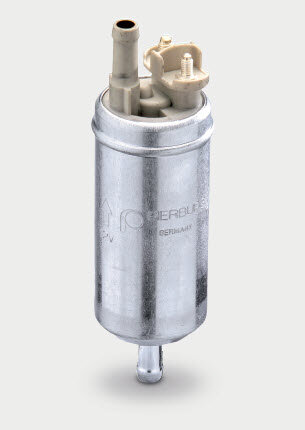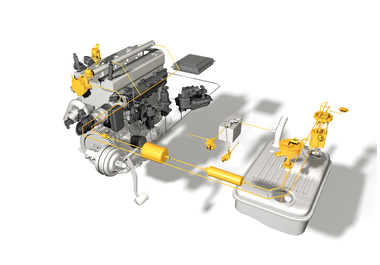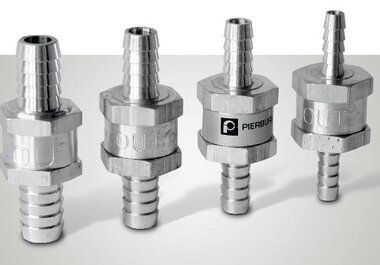
Electrical fuel pump E1F
as additional pump or for upgrades
Back to search
Information on use
Are you struggling to find a mechanical fuel pump for your veteran or classic car? Do you need a supplementary pump in your off-road vehicle, your generator, in motorsports or in your boat?
Are you missing a pre-feeder pump?
The E1F electric fuel pumps may be the solution. These universal pumps are suitable for system pressures of 0.1 to 1.0 bar, making them extremely versatile.
Vehicle: Universal application Product: Electrical fuel pump E1F Pierburg No.: 7.21440.51.0/.53.0/.63.0/.68.0/.78.0
Electrical fuel pumps of type E1F are very versatile in their application:
- As a replacement for a mechanical fuel pump (vintage/classic cars)
- As additional pump parallel to an existing fuel pump
- As a second pump that can be activated as required (e.g. in off -road vehicles, in motor racing)
- In generators or boats
- As a pre-feeder pump
Versions see table.
General notes on installation
The E1F (3) is installed in the fuel line. It is suitable for system pressures of 0.1 to 1.0 bar.
The maximum suction lift when lines are full is 500 mm. For this reason the fuel pump must be installed deep below the fluid level and close to the tank (1). Avoid large suction lifts and long or constricted fuel lines on the suction side. The fuel filter (4) (fine filter, paper filter) must always be situated on the discharge side, i.e. in the direction of the flow behind the fuel pump.
There is a risk of “dry running” with a fuel filter on the suction side. Dry running leads to damages in the pump system. A wide-meshed sieve filter (2) (mesh size 60 to 100 μm) can be placed in front of the fuel pump.
Type E1F fuel pumps feature a small separator in the intake side (exception: 7.21440.68.0). This separator must be removed before use in diesel vehicles.
The maximum suction lift when lines are full is 500 mm. For this reason the fuel pump must be installed deep below the fluid level and close to the tank (1). Avoid large suction lifts and long or constricted fuel lines on the suction side. The fuel filter (4) (fine filter, paper filter) must always be situated on the discharge side, i.e. in the direction of the flow behind the fuel pump.
There is a risk of “dry running” with a fuel filter on the suction side. Dry running leads to damages in the pump system. A wide-meshed sieve filter (2) (mesh size 60 to 100 μm) can be placed in front of the fuel pump.
Type E1F fuel pumps feature a small separator in the intake side (exception: 7.21440.68.0). This separator must be removed before use in diesel vehicles.
Example: Upgrading as additional pump
When using the E1F as additional pump it must be connected so that both pumps (3) and (6) can freely take in and feed. Taking in and feeding of a fuel pump through another is not possible. Fig. 4: To bridge the distance to an existing fuel pump (6), the E1F can be used as a second pre-feeder pump. For an existing fuel pump to be able to take in freely with the E1F switched off, a bypass line (7) must be layed around the E1F (3).
Fig. 5: An E1F parallel to an existing mechanical or electrical fuel pump increases the volumetric flow. The existing fuel pump (6) must be bypassed with a bypass line (8).
A check valve (5) must be installed in both bypass lines (7) and (8) so that the fuel does not flow back.
A check valve (5) must be installed in both bypass lines (7) and (8) so that the fuel does not flow back.
Electrical connection
The electrical fuel pump E1F is available for 12 and 24 Volt operation (see table).
For 6 Volt operation, i.e. for veteran cars, we recommend the E1F 7.21440.53.0. In this case, the pressure and volumetric flow reduce to approx. half. If the E1F is switched on via a separate switch, this must be installed in the positive cable.
Cross section of electric cables: at least 1.0 mm².
For 6 Volt operation, i.e. for veteran cars, we recommend the E1F 7.21440.53.0. In this case, the pressure and volumetric flow reduce to approx. half. If the E1F is switched on via a separate switch, this must be installed in the positive cable.
Cross section of electric cables: at least 1.0 mm².
Example: Replacement for a mechanical fuel pump (Fig. 6)
Older vehicles usually have a mechanical diaphragm fuel pump (9). It is directly positioned on the engine and is driven via cams and pushers/levers. In case of malfunctions of the mechanical fuel pump, in many cases it can be replaced by an electrical fuel pump E1F.
The “old” fuel pump (9) can be bypassed or removed.
If it is removed, the opening on the engine side must be sealed so that it is oil-tight. If it is bypassed, use a piece of tubing (10) to connect the inlet and outlet to one another to prevent dirt from entering. A check valve (5) should be installed in the flow line (11) so that the fuel does not flow back. For veteran cars a fuel return (12) is recommended (1 to 3 mm Ø, depending on the full-load consumption). An injector nozzle* must be installed in the fuel return (12) as flow resistor, so that
the fuel is pumped back into the fuel tank. The cross section of this nozzle must be calibrated to ensure the supply of fuel, even at full load. Problems of hot operation can be resolved by installing a gas bubble separator* (13). A check valve (5) should be installed so that the return line (12) does not run dry. The installation of a pressure regulating valve* (14) is recommended for some carburettors.
The “old” fuel pump (9) can be bypassed or removed.
If it is removed, the opening on the engine side must be sealed so that it is oil-tight. If it is bypassed, use a piece of tubing (10) to connect the inlet and outlet to one another to prevent dirt from entering. A check valve (5) should be installed in the flow line (11) so that the fuel does not flow back. For veteran cars a fuel return (12) is recommended (1 to 3 mm Ø, depending on the full-load consumption). An injector nozzle* must be installed in the fuel return (12) as flow resistor, so that
the fuel is pumped back into the fuel tank. The cross section of this nozzle must be calibrated to ensure the supply of fuel, even at full load. Problems of hot operation can be resolved by installing a gas bubble separator* (13). A check valve (5) should be installed so that the return line (12) does not run dry. The installation of a pressure regulating valve* (14) is recommended for some carburettors.
Key, Figs. 3-6
- Fuel tank
- Sediment separator (coarse fi lter)
- Electrical fuel pump E1F
- Fuel fi lter (fi ne fi lter)
- Check valve
- Existing fuel pump
- Bypass line around additional pump E1F
- Bypass line around existing fuel pump
- Mechanical fuel pump
- Connection between inlet/outlet of mechanical fuel pump
- Flow line/bypass around mechanical fuel pump
- Fuel return
- Gas bubble separator* or calibrating nozzle*
- Pressure regulating valve*
Accessories
Fuel sieve fi lter 4.00030.80.0
This fuel sieve filter protects the fuel pump from dirt and other foreign particles. It is installed in the fuel line between fuel tank and fuel pump.
The fuel sieve fi lter has a diameter of 8 mm at the suction nozzle and should be replaced at the same maintenance interval as the fuel filter.
This fuel sieve filter protects the fuel pump from dirt and other foreign particles. It is installed in the fuel line between fuel tank and fuel pump.
The fuel sieve fi lter has a diameter of 8 mm at the suction nozzle and should be replaced at the same maintenance interval as the fuel filter.
Fuel check valves
Fuel check valves are installed in fuel lines. They allow fuel to only flow in one direction and prevent tanks from draining or lines running dry.
Fuel check valves are installed in fuel lines. They allow fuel to only flow in one direction and prevent tanks from draining or lines running dry.
Safety shut-off *
When an electrical fuel pump is retrofitted, installation of a safety shut-off is mandatory.
The shut-off relay* (1) shuts off the fuel pump if the engine comes to a stop but the ignition remains on (e.g. stalled engine, accident). Key, Figs. 9
When an electrical fuel pump is retrofitted, installation of a safety shut-off is mandatory.
The shut-off relay* (1) shuts off the fuel pump if the engine comes to a stop but the ignition remains on (e.g. stalled engine, accident). Key, Figs. 9
- Shut-off relay* (available at specialist dealers)
- Ignition coil
- Electrical fuel pump E1F
- Fuse (10 A)
General safety information
- Work on the fuel system must only be carried out by specialist personnel.
- Only install clean parts. Make sure that impurities do not get into the fuel system.
- Only remove packaging and transport closures, e.g. plugs in new fuel pumps, immediately prior to installation.
- The aluminium housing of the E1F must not come into contact with salt water.
- Take care not to use material combinations that can lead to contact corrosion: do not allow the E1F to come into contact with galvanised surfaces, for example.
- Please note the applicable legal provisions and vehicle manufacturer’s instructions.
- Observe the safety instructions with regard to dealing with fuel and fuel vapours.
- Use hose clamps to secure fuel lines to connecting tubes.
- Following modifi cations, make sure that the fuel system is tight and that the operating licence is valid.
- Our fuel pumps are not licensed for use in aircraft!

